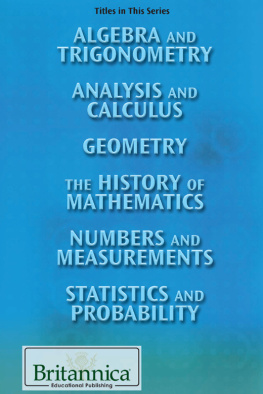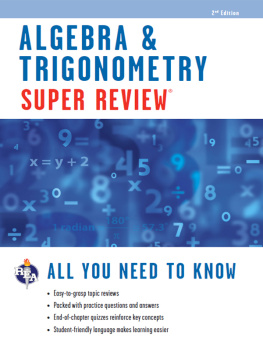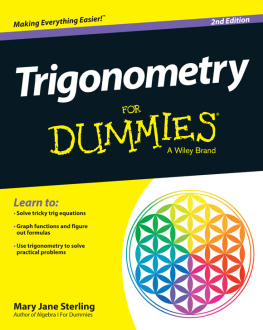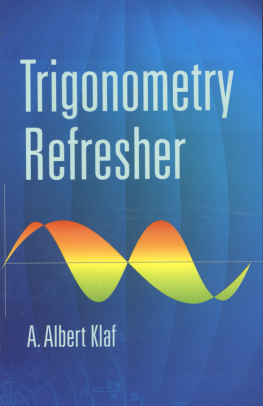HOMEWORK HELPERS
Trigonometry
DENISE SZECSEI

Copyright 2007 by Denise Szecsei
All rights reserved under the Pan-American and International Copyright Conventions. This book may not be reproduced, in whole or in part, in any form or by any means electronic or mechanical, including photocopying, recording, or by any information storage and retrieval system now known or hereafter invented, without written permission from the publisher, The Career Press.
HOMEWORK HELPERS: TRIGONOMETRY
EDITED BY KATE HENCHES
TYPESET BY EILEEN DOW MUNSON
Cover design by Lu Rossman/Digi Dog Design
Printed in the U.S.A.
To order this title, please call toll-free 1-800-CAREER-1 (NJ and Canada: 201-848-0310) to order using VISA or MasterCard, or for further information on books from Career Press.

The Career Press, Inc., 220 west Parkway, Unit 12
Pompton Plains, NJ 07444
www.careerpress.com
Library of Congress Cataloging-in-Publication Data
Szecsei, Denise.
Homework helpers : Trigonometry / by Denise Szecsei.
p. cm.
Includes index.
ISBN-13: 978-1-56414-913-8
ISBN-10: 1-56414-913-7
1. Trigonometry. 2. TrigonometryProblems, exercises, etc. I. Title.
QA531.S94 2006
516dc22
2006028234
Acknowledgments
Many people were involved in the production of this book, and I would like to thank the people who helped throughout the entire production.
I would like to thank Michael Pye, Kristen Parkes, and everyone else at Career Press for helping to turn my manuscript into the book you are holding in your hand. Jessica Faust handled the logistics so that I could focus on writing.
Kendelyn Michaels took time out of her busy schedule to help me polish my writing. Alic Szecsei helped reduce the number of typographical errors in the manuscript and was willing to spend his summer working out the solutions to the review problems.
My family continues to be patient with me, especially as my deadlines approach. Their willingness to take on extra responsibilities while I take care of the last-minute details does not go unnoticed.
Contents
Preface
Welcome to Homework Helpers: Trigonometry!
Trigonometry is a hybrid subject. It is based on a mixture of both geometry and algebra, and it involves the study of angles, triangles, and circles.
There are many applications of trigonometry. Global positioning systems use trigonometry to help a person navigate across town. Radar is another application trigonometry: it can be used to track planes and detect the speed of passing motorists. Physicists and engineers use trigonometry to analyze force diagrams and calculate the work done in moving an object. In addition to these practical applications of trigonometry, mathematicians use some of the methods developed in trigonometry to examine a wide variety of abstract mathematical systems including vectors and complex numbers. These applications of trigonometry primarily involve triangles.
Trigonometry can also be used to model repetitive or cyclic behavior. The orbit of a planet around its sun, the number of daylight hours, or the height of the high and low tides of the ocean can all be modeled using trigonometry. One of the strengths of trigonometry is that it is particularly useful when analyzing any type of phenomenon that exhibits circular patterns.
Learning trigonometry involves looking at problems from a new perspective. By combining the concepts in geometry with the problem-solving skills learned in algebra, trigonometry will enable you to solve some very interesting problems. It may take some practice putting these two branches of mathematics together, and this book will serve to guide you through the subject.
I wrote this book with the hope that it will help anyone who is struggling to understand trigonometry or is just curious about the subject. Reading an ordinary math book can be a challenge, so I tried to use everyday language to explain the concepts being discussed. Looking at solutions to math problems is often confusing, so I explain each of the steps I use to get from Point A to Point B. Keep in mind that learning mathematics is not a spectator sport. In this book I have worked out many examples, and I have supplied practice problems at the end of most of the lessons. Work these problems out on your own, and check your answers against the solutions at the end of each chapter. Your answer and my answer should match.
I hope that in reading this book you will develop an appreciation for the subject of trigonometry and the field of mathematics!
1
Functions
The concept of a function is very important in mathematics. A function is a set of instructions for how to combine numbers. Functions can be used to describe, or model, many situations in our everyday lives. Functions are introduced in algebra, and they are part of almost every aspect of mathematics. There are six new functions that we will define and analyze in trigonometry. These trigonometric functions are useful in modeling behavior that is repetitive, or cyclic. These functions can be used to predict the occurrence of the next lunar eclipse or the number of hours of daylight. They can also be used to describe the sound made when a guitar string is plucked. In order to study these trigonometric functions, we will need a solid understanding of the properties of functions in general.
Lesson 1-1: Representing Functions
A function is a set of instructions that establishes a relationship between two quantities. A function has input and output values. The input is called the domain and the output is called the range. The variable used to describe the elements in the domain is called the independent variable, which is commonly represented by x. The variable used to describe the output is called the dependent variable, as it depends on the input. An important feature of a function is that every input value has only one corresponding output value. A function can be represented in a variety of ways. Functions can be described using words, a formula, a table, or a graph.
Using a formula to define a function is a convenient way to describe the function in mathematical terms instead of using words. When analyzing a formula, it is important to use the order of operations. A function is often written y = f(x), where f(x) is an expression that involves the independent variable x. For example, the formula y = 2x + 1 defines a linear function. The name of this function is y. We could also have written this function as f(x) = 2x + 1. In this case, the name of the function is f(x). We use the notation y and f(x) interchangeably. When we identify a function using the notation f(x), the variable in parentheses, or the independent variable (in this case, x), is sometimes referred to as the argument of the function. Evaluating a function for a particular value of x involves replacing every instance of the independent variable with that value.
Scientists often collect data from various instruments and record this information in a table. These tables represent functions and provide an easy way to describe a complex, or unknown formula.
Next page











